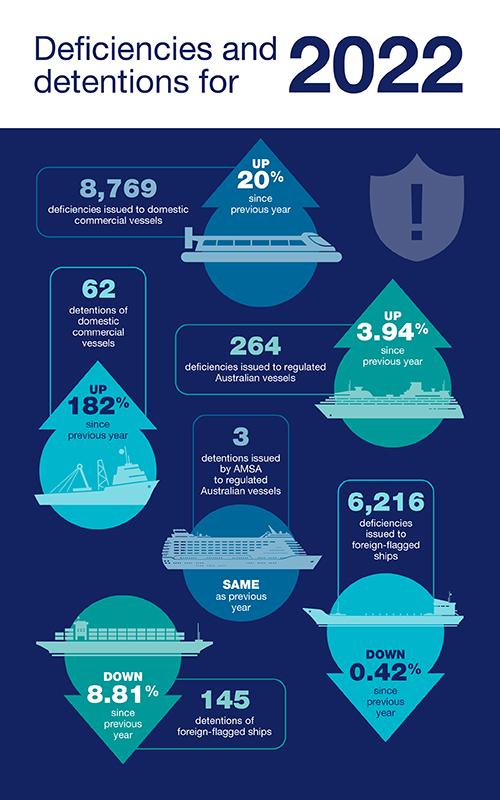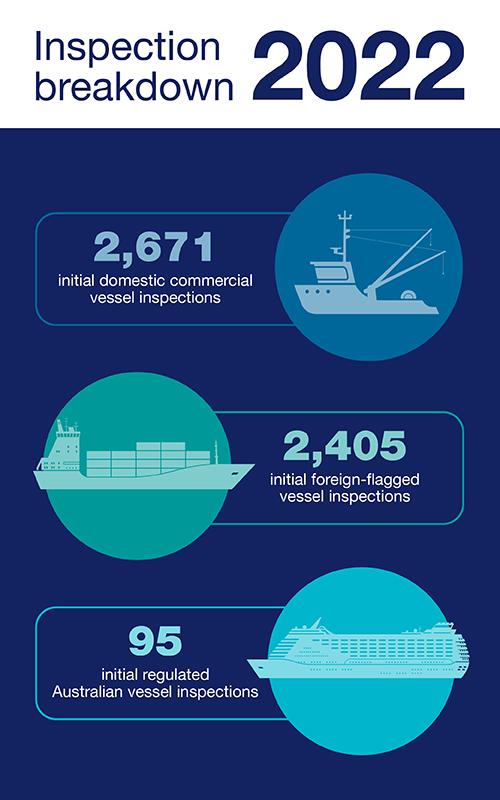AMSA has issued its Inspection Report for year 2022 revealing that container ships are in the top five detained ship types for three years, accounting for nearly 15 per cent of arrivals during last year. In 2022, 1,181 bulk carriers were inspected with 3,446 deficiencies issued resulting in 76 detentions. The detention rate for bulk carriers increased to 6.4 per cent from 6.1 per cent in 2021.
According to the report, the average PSC deficiencies per inspection increased from 2.2 per cent in 2021 to 2.58 per cent in 2022. This is significantly higher than the 10-year rolling average of 2.3 deficiencies per inspection. AMSA’s DCV (Domestic commercial vessels) inspection processes continue to be imbedded into normal operations. The increase in detentions of DCVs reflects the importance AMSA places on protecting crew, passengers and the marine environment. The reduction in the number of initial PSC inspections, with the increase in detention rate shows that AMSA is directing resources towards ships of a higher priority, while not inspecting ships of a lower priority.

Year in Review
AMSA inspectors undertook the following in 2022;
- 2,671 initial DCV inspections on DCVs
- 95 initial FSC inspections on RAVs
- 2,405 initial PSC inspections on 2,167 foreign flagged ships.
- 1,122 follow up inspections on foreign flagged ships
- 54 follow up inspections on Australian RAVs
There was a 6.2 per cent increase in the number of initial DCV inspections conducted by AMSA. This is the most inspections conducted since AMSA assumed service delivery of the national system.
There was a nearly 20 per cent increase in the number of deficiencies issued to DCVs, from 7,311 in 2021 to 8,769 in 2022. There was a 182 per cent increase in the total detentions2 of DCVs, up from 22 detentions in 2021 to 62 detentions in 2022. The number of initial FSC RAV inspections remained the same as 2021, at 95. Australian ships underwent two initial PSC inspections overseas, with one inspection resulting in a detention. AMSA seeks to focus its inspection efforts on those ships considered a higher risk to Australia.

While there was a 14.7 per cent decrease in the number of initial PSC inspections, AMSA increased the inspection rate of Priority 1 (P1) ships, inspecting 88.5 per cent of all eligible arrivals of P1 ships. We decreased the inspection rate of Priority 4 (P4) ships, inspecting 24.5 per cent of eligible arrivals. The PSC results show that there was a slight increase in the detention rate of ships from 5.6 per cent in 2021 to 6.0 per cent in 2022. The peak detention rate was in 2011 with 9.2 per cent. The 2022 detention rate is consistent with the 10-year rolling average of 6.0 per cent.
Key Points
- 82 per cent increase in the number of detentions of DCVs, from 22 in 2021 to 62 in 2022.
- The inspection rate of RAVs remains consistent at 95 per year. The number of detainable deficiencies identified on RAVs fell by 43 per cent (from seven in 2021 to four in 2022).
- 1,181 bulk carriers were inspected with 3,446 deficiencies issued resulting in 76 detentions. The detention rate for bulk carriers increased to 6.4 per cent from 6.1 per cent in 2021.
- Container ships continue to perform poorly, being in the top five detained ship types for three years, and accounting for nearly 15 per cent of arrivals in 2022.




























































